Hiking on the thriving island of Madeira
| Second hiking week |
|
Contents
Second hiking week
2) Hiking Day 6: Morning: From Eira do Serrado to Curral das Freiras (Nonnental) Afternoon: Monte near Funchal
3) Hiking Day 7: Funchal
4) Hiking Day 8: Levada Caldeirão Verde and Levada Caldeirão do Inferno
5) Hiking Day 9: Morning: Swimming in Seixal Afternoon: Circular route from Fanal to Fio
6) Hiking Day 10: From Pico do Arieiro to Pico Ruivo
7) Hiking Day 11: Circular route Paul do Mar and Jardim do Mar
8) Hiking Day 12: From Camacha to Sítio das Quatro Estradas
9) Hiking Day 13: Morning: From Pico do Facho to Canical Afternoon: The Whale Museum
10) Departure Day: Jardim Botânico in Funchal
|
Map of our hikes

15.07. - From Eira do Serrado to Curral das Freiras (Nonnental) and Monte near Funchal - Tour 6
Spontaneously we decided today to do the hike to the Nun's Valley (Curral das Freiras) in the morning and to visit Monte with the beautiful park (near Funchal) in the afternoon.
As stated, hike no. 36 (Rother) is recommended to be done only downhill, because the descent is steep at 475 meters in altitude.

From the town of Curral das Freiras you can then take the 81 bus back to Eira do Serrado. Here you have to be careful that you catch the right bus, which goes via Eira do Serrado and not directly to Funchal. It is best to study the bus timetable carefully beforehand - there is one each at 1:25 p.m. and 2:30 p.m.
Hike: Rother No. 36 - see map: Tour 6
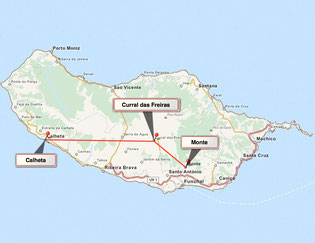
Start and finish: Eira do Serrado car park
3 hours 30 minutes, walking time 1 hour 10 minutes
4.3 km, 30 m ascent, 475 descent
Difficulty level: medium
Google-Map: https://goo.gl/maps/23cC7
Viewing platform Eira do Serrado
First, however, we went up to the viewing platform of Eira do Serrado, one of the usual tourist stops. The hiking trail into the valley, on the other hand, was not very busy, we only saw one family. The path meanders into the valley with wonderful views, the nature is beautiful, but not as impressive as the hikes of the days before.
When you arrive in the valley, you will unfortunately be asked at every restaurant whether you would like to have a drink. After visiting the church, we found out that the bus at 12:30 p.m. unfortunately does not go to the starting point. So we first took a lunch break in a restaurant and ate roast pork with chestnuts (the specialty of the remote valley).
Monte near Funchal
The second tour of the day went to another of Madeira's tourist highlights, Monte, which sits high above Funchal and the Monte Palace Tropical Garden. A slightly higher parking lot is recommended, as the streets are narrow and busy there. Alternatively, you can also take the cable car up to Monte.
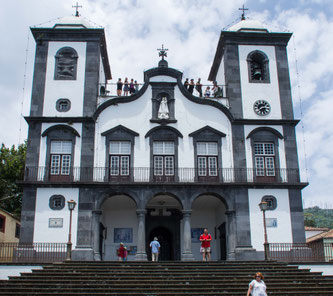
The Sanctuary of Nossa Senhora do Monte offers great views of the city and is well worth a visit. Particularly impressive is the Tropical Garden, which is worth the €10 entry fee per person.
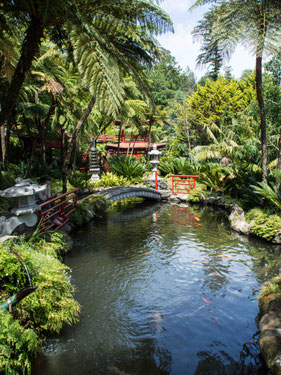
Gorgeous flowers but also sculptures and especially the tiled mosaics and pictures delight the eye. You can choose different themed circular routes or simply explore the small paths and corners on your own. The pilgrimage church of Nossa Senhora do Monte offers a wonderful view of the city and is worth a visit. Particularly impressive is the Tropical Garden, which is worth the €10 entry fee per person.
A short coffee break rounded off the visit to the park.
Finally, we enjoyed the basket toboggan rides that are offered from the top of the park. The smart drivers are there, waiting for customers, who then drive down the narrow street, cheering.
16.07. - Funchal - Tour 7
Today there was no hike on the program, but we visited Funchal.
As the capital of Madeira, about half of all inhabitants live there and Funchal is the economic center of the island. Incidentally, the name comes from "a lot of fennel", because the Portuguese found an enormous amount of fennel there. We parked in the car park, Almirante Reis, near the cable car/market, which makes sense as we only paid €5.80 for the day.
- see map: Tour 7
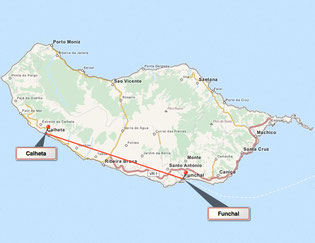
Start and end: Almirante Reis car park
7 hours, walking time 3 hours
10.8 km, ascent and descent 110 m
Difficulty level: easy
Google-Map: https://goo.gl/maps/L51wv
From the parking lot we first went in the direction of the old fortress of São Tiago....
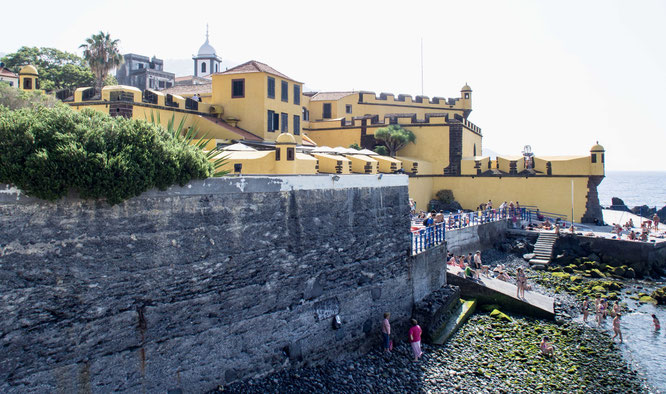
... and visited the church Igreja do Socorro. You could also have a nice view of the bay, where there are numerous rocky bathing opportunities, which we didn't use anymore in the late afternoon due to the advanced time. Then we went through beautiful alleys, along many hand-painted front doors through Funchal to the Sé Cathedral.

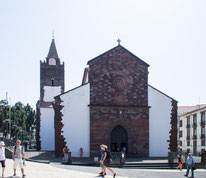

Then we had a short coffee break, which included one of the delicious sweets and we were strengthened for the time being. It is generally advisable to visit the smaller localities that are less touristy.
After our little break we went up to the town hall, which has a very nice entrance area. Then we visited the opposite magnificent Jesuit Church (College).


You can see many of the lovingly hand-painted old front doors in Funchal.
Incidentally, some of the museums specified in the travel guide were closed or no longer existed (e.g. the Sugar Museum and the Madeira Story Centre), but fortunately the home of Frederico de Freitas, including his magnificent tile collection, was open and can be visited for an entry fee of €3 per person . For us, one of the main characteristics of Madeira will be the magnificent tile art that can be seen and admired on every corner. Afterwards we visited the English Church with its pretty garden and cloister and then decided to take our well-deserved lunch break. In general, the Madeirans eat lunch between 1 and 3 p.m. and dinner after 8 p.m. and we have quickly adapted to this rhythm. As a starter there were mussels again, which we can recommend - as well as the small local restaurant.
The seat of government "Quinta Vigia" of Madeira is located above a beautiful park; also a pretty chapel is in the complex. The building is adorned with the coat of arms of Madeira - as tiles, of course.
Above is the casino, a more modern building. The way back went along the Avenida Arriaga, where there are some magnificent buildings. There is also the wine museum of the Madeira Wine Company, which we did not visit due to lack of time. We decided not to buy Madeira from the adjacent shop, but to do so at the airport (the prices are said to be the same).
The visit to the market hall, where we bought some fruit, was the conclusion of the visit to Funchal. It is generally advisable to do this in the morning when the fish stalls are still busy - they were being cleaned when we were there.
And at the end of tonight the recipe for the national drink Poncha, which we successfully tried again in our apartment :-)
4 squeezed oranges
2 squeezed lemons
6 tablespoons of honey - mix everything together well
and then by feel (amount approx. 1/5) sugar cane brandy, the brand Branca (40%) is recommended and enjoy everything at room temperature!
17.07. - Levada Caldeirão Verde and Levada Caldeirão do Inferno - Tour 8
Getting up early proved itself again, because today's hiking destination was the popular Caldeirão Verde - the green cauldron - and then we continued to the cauldron of hell - Caldeirão do Inferno.

Hike: Rother Nr. 28 combined with No. 29 - see map: Tour 8

Start and end:
Parking Casa da Queimadas
7 hours, walking time 5 hours 30 minutes
19.3 km, 110 m ascent, 110 m descent
Difficulty level: medium
Google-Map: K7QcSezq7CmFDEdY6
This levada tour is extremely popular and even early in the morning at 8:15am we were not the first to start the hike. The first part of the hike (Rother No. 28) into the green basin is easy to walk and the few steep sections that require a head for heights are all secured with a strong rope railing.
After a few tunnels, the green basin, the first part of the hike, was very idyllic on a slight rise at the end of the valley. The rock walls built up in front of you and a 50 m high waterfall tumbled down into the kettle.
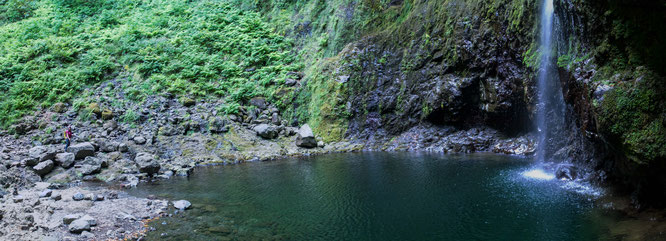
The second part into the Höllenkessel (Rother No. 29) is also not very demanding, but overall the length of the hike is relatively exhausting at around 18 km. The path went on and we had to overcome about 75 meters of altitude with steps and panted a bit. To the right we now went to a higher levada to the cauldron of hell. There were more tunnels this time, some fairly low (about 4 feet) that even Judith had to duck her head.
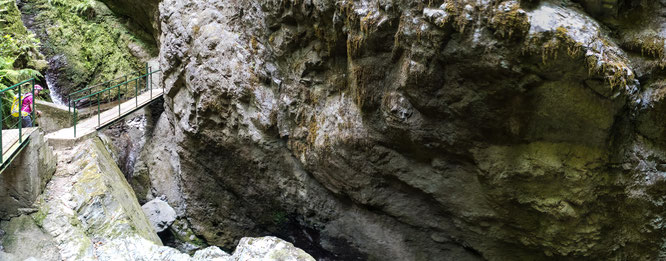
The most impressive part of the hike was not the hell's cauldron, but the gorge before it, where several waterfalls plunged into the depths.
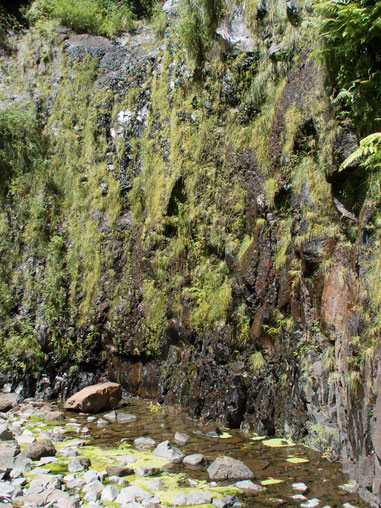
Shortly thereafter we reached the Höllenkessel, located similarly to the green Kessel with very high cliffs. At another time of the year (it's relatively dry now in summer) this cauldron with more water will certainly be very impressive. But then the tunnels will also be a greater challenge, because even today there were many puddles of water that we had to wade through.
Unfortunately, the way back was very crowded with tour groups and many families. Then a levada walk is less fun, because you have to constantly avoid oncoming people and trott behind one another.
This time we also made short videos that give an impression of walking on a levada and through a tunnel.
18. 07. - Swimming in Seixal und hiking from Fanal to Fio - Tour 9
Actually, we had planned the Fajã Quebrada Nova hike today, where you climb about 500 meters down to the sea and then take a small cable car up again. However, when we got to the top of the cable car station and saw how steeply and spectacularly an older gondola descends without any further supports, we were skeptical and changed our plans.
Hike: Rother No. 46 - see map: Tour 9
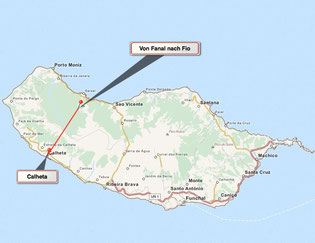
Start and end:
Road to the forester's house in Fanal
1 hour 20 minutes, walking time 1 hour 20 minutes.
4.7 km, 100 m ascent, 100 m descent
Difficulty level: easy
Google-Map: seT3Ss1CjsNGSxYH8
First we went to Seixal to swim in the sea basin Piscinas naturais do Seixal. This is not so easy to find. If you come from Porto Moniz and take the first exit, it is below a post office (there is also a viewing parking lot) and in front of the church. A small, narrow street goes steeply downhill and if it's not too crowded, you can definitely drive down there and park (but it can get narrow :-). There are two beautiful sea pools where swimming is fantastic, especially when the weather was so hot and it was good to cool off.

Circular route Fanal to Fio
After a delicious lunch in the Solmar restaurant (local meat skewers on laurel sticks, cod and marinated squid with garlic bread first), we went up a narrow, small road to the plateau to our new hiking destination, Fanal (Rother No. 46).
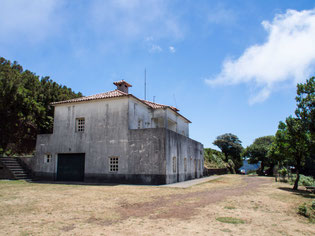
This hike, which is indicated as easy, has its special charm due to the nature. We started at the forester's house and admired the old, gnarled laurel trees. There is also a picnic area where a family enjoyed the meal. Some Madeirans will probably ask themselves why we tourists only walk around in hiking clothes in warm weather instead of enjoying a picnic in the countryside and resting like them.
We went up a flight of stairs to the hill and a wonderful view down to the sea revealed itself to us.
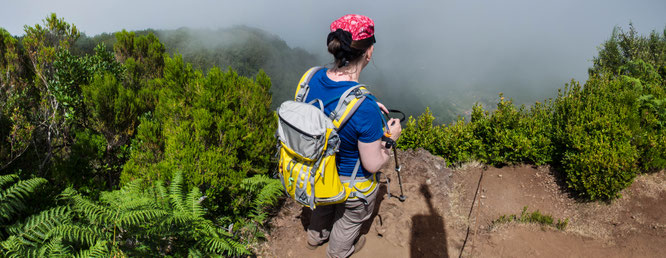
At the same time, however, the first wafts of fog and clouds, which are typical for this location, were already visible and the atmosphere was mystical. Through tall ferns and heather we followed a path down to another viewpoint on Seixal, but could see little as the clouds in the valley had increased by now. Some cows searched for the sparse grass and blocked our way to another viewpoint - since they also had calves we didn't want to disturb them. The way back led over a gravel and sand path; the sun was burning hot and there was an intense smell of mint. A very small light blue flowering plant grew on the ground, not comparable to the large mints that we know. In the evening there were still some clouds over the island, but not over the sea, so that we could enjoy a beautiful sunset.
19.07. - Hike Pico do Arieiro to Pico Ruivo - Tour 10
Today was the king's tour, the hike of all hikes here on Madeira and by far the most demanding. It connects the three highest peaks of Madeira, offers fantastic views and is clearly classified as an alpine hike. It leads from the Pico do Arieiro around the Pico das Torres to the highest mountain, the Pico Ruivo and back.
Hike: Rother No. 34 - see map: Tour 10

Start and end:
Parking at Pico do Arieiro - 1818 m
8 hours, walking time 6 hours
approx. 15 km, ascent and descent 900 m
Difficulty level: hard
Google-Map: 5TkCzuH6XDyPkKWq7
This time we started even earlier than usual to be on the Pico do Arieiro before dawn. There is a large parking lot, a self-service restaurant, a kiosk and therefore everything that tourists need during the day is there. The hiker, on the other hand, comes early, but this Sunday there were only a few who walked the entire tour. The blue hour was terrific and we enjoyed the minutes of sunrise, which shrouded the mountains in a red light.
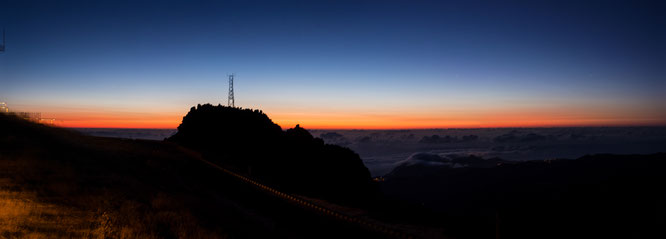
First we went to the Pico do Arieiro, from where we enjoyed the view and then steeply downhill to the fork in the east and west routes around the Pico das Torres. We wanted to walk both routes and initially decided on the longer and more strenuous east route.
In the meantime the sun had risen, there was a layer of clouds over the sea and suddenly it got warmer and warmer.

It went through a gorse bush landscape and we looked into the Fajã do Nogueira valley, where we had walked along the levada a few days earlier.
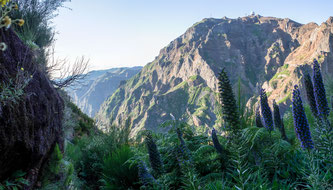
Unfortunately, when we got back to the fork of the two routes, we had to walk a fairly steep detour, necessitated by a complete rock fall where the old trail used to run.
This detour certainly cost an additional 200 meters in altitude and it is extremely steep uphill, sometimes over ladders. On the way back we met a group of French hikers who were sweating and unfortunately dressed completely inappropriately and even dangerously for this mountain world (often only sneakers, thin dresses, without drinks ... from our point of view you should even have telescopic poles with you on this route, which help a lot with support). In any case, this section is really no fun. Then it went up in winding serpentines to the hut of Pico Ruivo through the greening landscape of a former forest fire area. There we didn't take a break to first climb the last 100 meters to the summit and enjoy the wonderful panorama and the all-round view of the entire island.

When we got back down to the hut, we ate the sandwiches we had brought with us and drank some coffee. An easy hiking trail from Achada do Teixeira also leads up to the Pico Ruivo, so that it was heavily frequented.
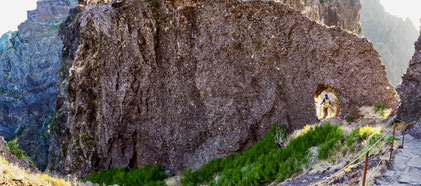
The way back then went via the west route with some tunnels. This route is much easier and shorter and we were also happy about it, as we gradually noticed - at least Judith - our exhaustion.
The many steps on the hike, some of which are very high, are particularly grueling. The last section back up to the Pico do Arieira is again violent with many steps and not so refreshing in the hot sun. Incidentally, we were really lucky with the sunny weather, since clouds usually gather there from midday onwards.
Overall, the tour is doable if you have the right clothing, but it could be made easier by taking the west route around Pico das Torres both times.
20.07. - Circular route Paul do Mar -Tour 11
Rother writes: "Descent to the sea and grandiose re-ascent, ... one of the few opportunities to walk directly along the sea." Thomas says: "Walking 550 meters down the stairs, balancing about 2.5 kilometers on a pier and climbing the wall 550 meters in a heated lava grill."
Hike: Rother No. 55 - see map: Tour 11
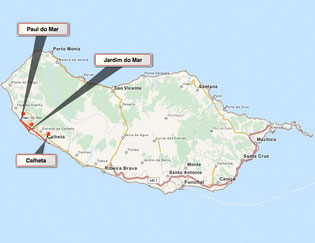
Start and end:
Parking 2 Hotel Jardim Atlântico, Prazeres
6 hours including eating and bathing, walking time 3 hours 15 minutes
6.8 km, ascent and descent 550 m
Difficulty level: hard
Google-Map: https://goo.gl/maps/1XMA4
Today Judith wanted to take things a little easier because she had caught Zug behind her yesterday, but Thomas was as motivated as ever. This is how the plan came about that Thomas first drove Judith to Paul do Mar, he then wanted to walk the descent and ascent alone and both only wanted to walk the sea route from Paul do Mar to Jardim do Mar together. Said and done.

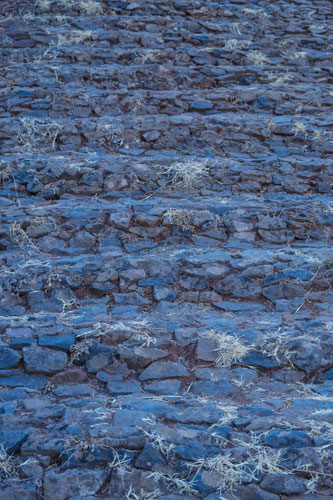
While Judith drank a coffee downstairs in a small bar and read her detective story, Thomas walked off from the parking lot at the Hotel Jardim Atlãntico. From then on, the path to Paúl do Mar consists only of the typical wavy steps, which have a step height of 10 cm and a step depth of about 40 cm. This does not allow you to walk down the mountain with a normal long step, but you have to tiptoe in front of you. Nevertheless, Thomas ran down the mountain in 36 minutes, but 50-60 minutes is more realistic.
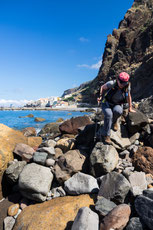
From the harbor we went together over the pebble or rather rocky beach. You should always check the tides carefully here in advance, because a narrow passage can only be passed at low tide if the sea is reasonably calm (approximately within a time window of 1.5 hours). The sun was scorching hot and climbing over the boulders was extremely strenuous as each step has to be taken carefully.
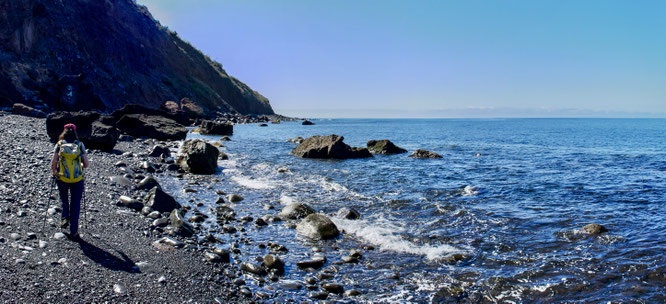
We arrived in Jardim do Mar quite sweaty and walked along the beautiful beach promenade to the rear bay, where there is also a shower. Rarely had a refreshing sea bath been longed for more than on today's hot day after this route. Afterwards we treated ourselves to a delicious lunch at Joe's Bar, which really comes highly recommended, especially for the large selection of freshly squeezed juice. We chose passion fruit juice, followed by the now obligatory limpets and then scabbard fish and grilled squid.
Now Judith was able to recover and sat down with the thriller on the market square in Jardim do Mar, which is a very pretty, crooked little place by the way.
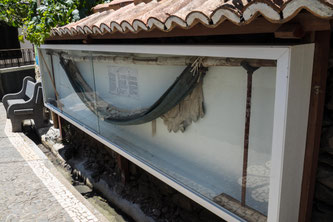
Thomas continued on his way. The first thing he reached was the display case, in which an old sling is on display, which was used to carry the wealthy, priests and sick people across the island. Since neither porters were in sight nor Thomas belongs to one of these groups of people, he continued on foot.
The way up is very exposed, there are extremely high steps, some are slippery when wet and the side vegetation that gets in the way consists partly of cacti. Thomas pulled a spike out of his arm and one out of his cane grip. Otherwise, this strenuous path is actually the most beautiful part of the hike. Then Thomas picked Judith up again in Jardim do Mar and we visited the pretty church.
Finally, our opinion on this tour is the following: you can do it, you don't have to. There are much nicer tours, also with a view of the water and cliffs. However, Jardim do Mar is worth a visit.
21.07. - Hike from Camacha to Sítio das Quatro Estradas - Tour 12

Today we decided again for a levada hike, namely hike no. 10 (Rother), which is advertised as a beautiful hike through the cultural landscape of Madeira. And it also fully met our expectations as a little-used and therefore non-touristy hike along the levada with insights into agriculture - and unfortunately the realization that many areas here are no longer used and lie fallow.
Hike: Rother No. 10 - see map: Tour 12
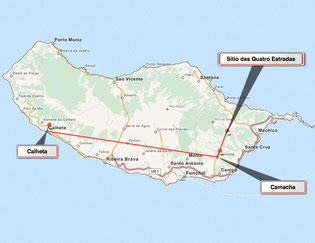
Start: Camacha Largo da Archada bus stop End: Sítio das Quatro Estradas bus stop (to Camacha with line 77)
5 hours 20 minutes including bus ride, walking time 4 hours 30 minutes.
15.7 km, 165 m ascent, 115 m descent
Difficulty level: hard
Google-Map: https://goo.gl/maps/KMkEB
Since this hike is not a round trip and is very long at approx. 15 km, we first drove to the arrival point in Sítio das Quatro Estradas and from there took the bus to Camacha. Here, too, always check the departure times on the Internet beforehand, because the bus only runs every 1-2 hours. The bus left at around 9:10 a.m. and we were able to start in Camacha at 9:30 a.m. First it was a steep descent down a residential street (GPS planning is recommended here to find your way) and then to the right to the start of the hike, which begins with a small, very low tunnel.
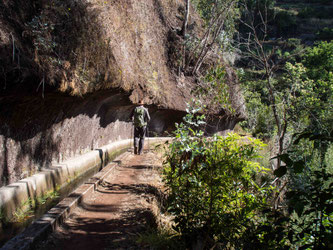
And then for the next 5 hours it always goes along the Levada dos Tornos, which is also quite exposed in parts and requires a head for heights.
We crossed cultivation terraces, walked past small farms/houses and marveled at the most diverse types of fruit, which we could not all identify. The wild fennel grew along the way and banana passion fruit twined with beautiful pink flowers and still green fruits. From time to time we looked across the valley to the sea and also to the airport, which is not very far away. Some wild growing yellow plums were nibbled and of course we made our little lunch break with spread bread. Although the sun was beating down, there was a sometimes quite strong wind at midday.

From time to time we looked across the valley to the sea and also to the airport, which is not very far away. Some wild growing yellow plums were nibbled and of course we made our little lunch break with spread bread. Although the sun was beating down, there was a sometimes quite strong wind at midday.
At the end of the hike, we went up a steep stairway, through a settlement and past a transformer station to the starting point. As a precaution, we had parked our car a little further down and therefore didn't have to walk all the way up.
22. July - Hike from Pico do Facho to Caniçal and to the whale museum - Tour 13
Since the weather is still very warm - we have really always had wonderful sunny weather during the two weeks of vacation - we decided today for a shorter tour in the morning. The destination was the east side of the island to learn a bit more about the history of Madeira at the time of whaling. We chose the Rother tour no. 11 "along the east coast on the whaling trail".
Hike: Rother No. 11 - see map: Tour 13
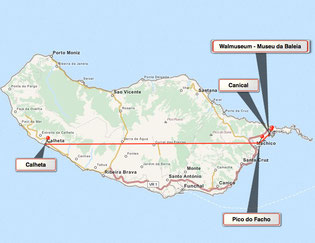
Start: Pico do Facho junction just before the old Caniçal Tunnel.
walking time 2 hours
5.1 km, 140 m ascent, 350 m descent
Difficulty level: medium
Google-Map: https://goo.gl/maps/yDU22
The east coast is rather barren and sunny, but we were lucky in the morning that there were a few small cumulus clouds that shaded the first part of the way. First we drove to Caniçal by car and parked it near the whale museum, which we wanted to visit afterwards. There is also a bus from Caniçal to the starting point of the hike (just after the old tunnel towards Machico) but as we were early we took a taxi for only €10.

First we went up a tarred road to the Pico do Facho, which used to be a pirate lookout. There is a picnic area and many transmission towers and you have a nice view of Machico and the airport. Then we went to Caniçal via a beaten track. You have to be careful with the route here, some of the markings are made with blue plastic tapes (or red dots that are hardly visible anymore). A few goats were on the dry meadows and pastures, countless cacti (prickly pear cactus) with wonderful orange-red flowers pleased the eye. Again and again you had a beautiful view of the sea, in the background São Lourenco and in the haze in the distance the Desertas Islands.

We slowly descended towards Caniçal and finally arrived at a bathing bay with shower facilities, where we happily took a refreshing dip in today's somewhat stronger surf.
The Whale Museum

Refreshed, we then went to the whale museum, which has succeeded in making a very good connection between the earlier history of whaling and today's protection of whales. You learn under what harsh conditions whaling was once practiced on Madeira, how more and more technology was used until Madeira happily ended it in 1981.
At the end of the trip to the east of Madeira we had dinner again in the delicious restaurant Lily's in Machico.
23.07. - Jardim Botânico and day of departure
On the day of departure, due to the late flight time back to Hamburg (departure at 4:40 p.m., arrival at 10:00 p.m.), we were able to schedule the morning for a trip to the botanical gardens in Funchal - Jardim Botânico. We parked above the botanical garden at the exit of the cable car station; there is free parking there. Admission costs €5.50 per person.
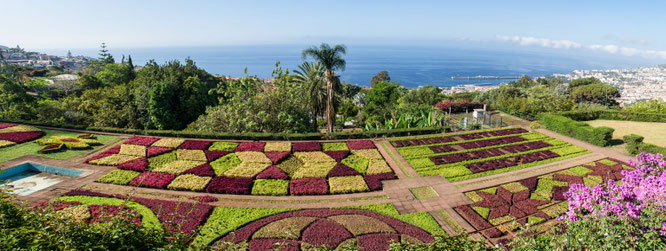
Unfortunately, there is no leaflet with a plan showing where the individual areas are, so you have to use the information boards to find your way around. Like apparently everything on Madeira, the botanical garden is also located steeply on a slope, which has a great creative appeal for the beds and paths. Particularly impressive is the large terraced complex in the middle with different colored plants (leaves) forming ornaments. In the background is the main building, which houses a natural history museum. Various minerals, fossils, stuffed birds and other animals are on display in the ancient rooms. In the lower part of the garden there are aviaries with various birds, especially many species of parrots. We were impressed by the variety of plants and flowers, although we regretted that only a few had name tags - we would have liked more information, particularly on the endemic plants.
We drank a coffee and a Brisa Maracuja (our new favorite lemonade) in the downstairs café and then - before we finally went to the airport - had lunch in the upstairs snack restaurant, the quality of which was quite decent.
We were then relatively quickly finished with our last vacation program, since we had already caught the travel fever and we wanted to be at the airport early enough. And so a wonderful Madeira vacation came to an end.
back to the first hiking week
to my other English blogs










